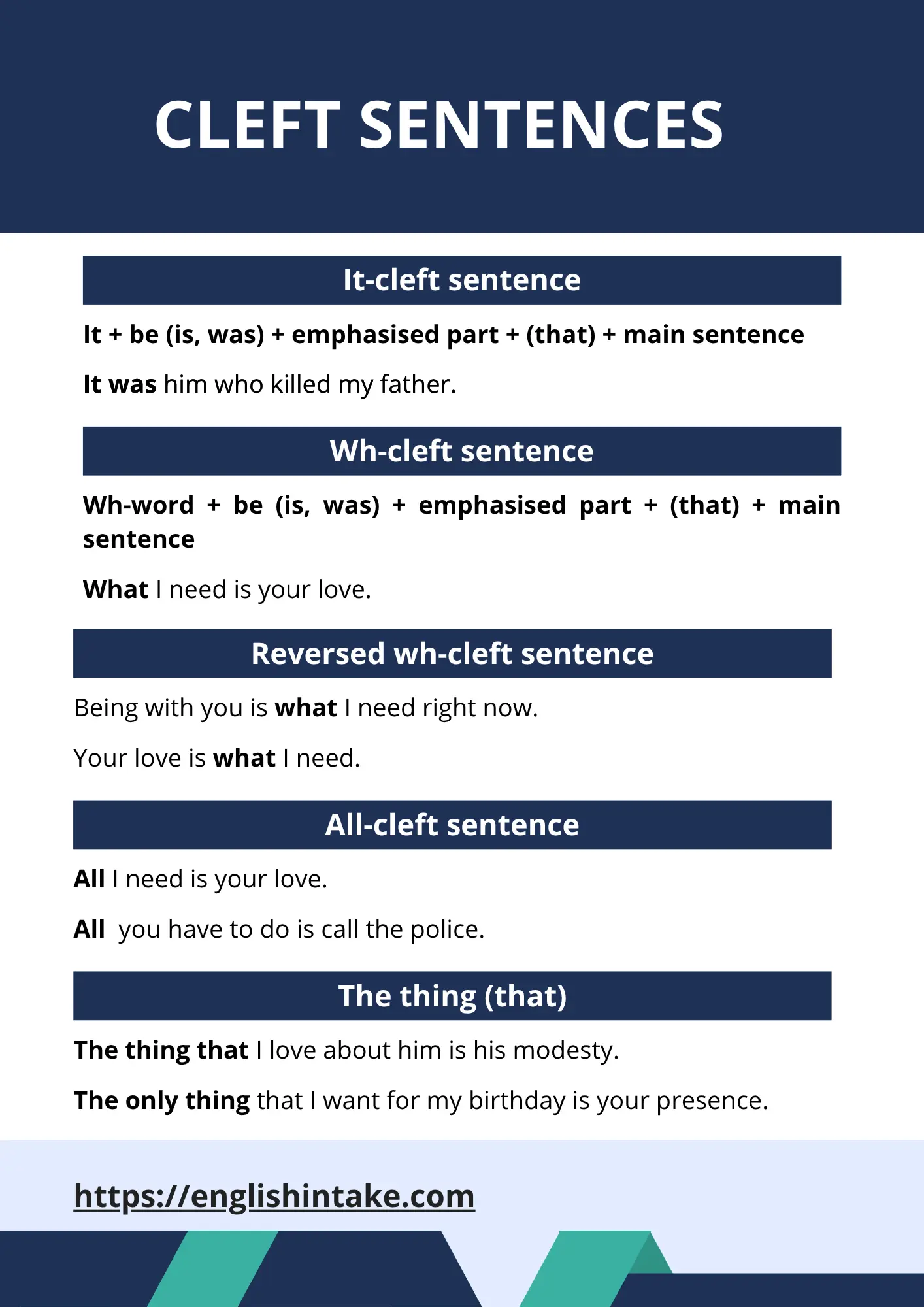1. What are cleft sentences?
In English, cleft sentences are used to emphasise certain parts of a sentence, such as the subject, object, or time expression. They are particularly useful when you want to draw attention to one element, like the person performing the action, the thing being acted upon, or the specific moment or duration of an event.
2. Usage
Clef sentences are usually used to answer specific questions, especially when you want to give extra emphasis to something in a sentence. They are commonly found in English conversation and writing to make the message clearer. They are formed by splitting a single idea into two parts. The sentence is "split" (or "cleft") to give special attention to one part.
3. Types
There are different types of cleft sentences in English. Let's look at the most useful one.
3.1 It-cleft sentences
An it-cleft sentence is used when we want to boost a specific part of a sentence by giving it extra weight or focus.. It usually starts with "It is" or "It was".
Structure: It + be (is, was) + emphasised part + (that) + main sentence
Examples
1. It was the teacher who helped me with my homework. In this sentence, the emphasis is placed on the teacher.
2. It is English that is spoken in the UK. Here, the emphasis is on the language (English).
3. It was my brother who taught me to play the guitar.
4. It was my father who taught me to never give up in life.
3.2 Wh-cleft sentences (also called pseudo-cleft sentences)
A wh-cleft or pseudo-cleft sentence is similar, but it uses a wh-word (like who, what, where, when, or why) to introduce the part that is emphasised.
Structure: Wh-word + be (is, was) + emphasised part + (that) + main sentence
Examples
1. What I need is more time to finish my work. The focus here is on the need for more time.
2. Where the meeting will be held has not been decided. The emphasis is on the location of the meeting.
3. What I want to see is your smile. The focus here is on the speaker's desire to see a smile.
4. What she needs is love. The emphasis is the need for love.
3.3 Reversed wh-cleft sentences (or reversed pseudo-cleft sentences)
In a reversed wh-cleft sentence, the focus element (the part of the sentence that you want to emphasise) is placed at the beginning, followed by the verb be and the rest of the sentence (the complement).
Examples
1. A new iPhone is what I want for my birthday.
2. Talking to my mother is what I need now.
3. Having a house was what he had always dreamed of.
4. A vacation is what I need after this stressful week.
5. Her reaction was what shocked everyone.
3.4 All-cleft sentences
All-cleft sentences follow a similar structure as wh-cleft sentences, except that they begin with the word "all" instead of "wh-words".
1. All it takes is a little patience.
2. All I need right now is a good break.
3. All you have to do is follow the instructions.
4. All we hope for is a peaceful resolution.
5. All we need is love.
6. All she wanted to hear was that everything would be okay.
7. All I want is you.
3.5 Other types
Cleft sentences can also begin with the thing (that), the only thing (that), the last thing (that), and something (that).
1. The thing (that) I appreciate the most is your honesty.
2. The only thing (that) I want for my birthday is a book.
3. The last thing (that) I expected was a surprise party.
4. Something you should know about me is that I love animals.
5. Something (that) I will never forget is my last moment with my father.
6. The only thing (that) I need right now is some rest.
7. The last thing (that) I saw was her smiling face.
4. Negative form
Cleft sentences can be negative. Study the examples below.
1. It wasn’t until she left me that I realised I loved her.
2. It wasn’t until my parents passed away that I realised life was hard.
3. What I wanted wasn’t your money.
4. Where I wanted to work wasn’t Canada.
5. All I wanted to buy was not in stock.
5. Importance
Cleft sentences are very helpful in English when you want to make a point clearly or emphasise a particular piece of information. By using these structures, the focus can be placed where it is needed, making the message easier to understand. They are used in many types of communication, from everyday conversations to formal writing.
6. Examples in everyday situations
Here are some more examples of cleft sentences that could be used in daily life:
1. It was my brother who fixed the car. The focus is on the person who did the action.
2. What she said was very interesting. The focus is on the content of what was said.
3. Where the concert will be held has not been announced yet. The focus is on the location of the event.
4. It is for you that I am doing all this work. The focus is on the person for whom the action is being done.

